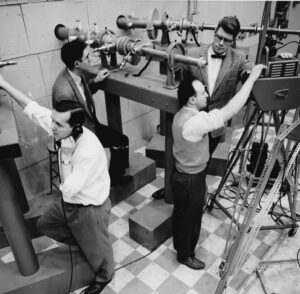On Friday, May 2, 2025, Walter Woytowich, long-time Deep River resident, was expecting to celebrate his 100th birthday with a small group of friends. Unfortunately, on that day his health took a turn for the worst, the celebration was cancelled and four days later he passed away.
At the start of 1948, Walt, a native of St. Catharines, ON, took up a position at Chalk River in the neutron-scattering group led by Don Hurst. His move to Chalk River was partly spurred by the challenge of the exciting work he saw described in a newspaper ad and partly to escape the debilitating hay fever that the southern Ontario climate caused him.
Walter put his creative talents to bring many improvements in the equipment and electronics used by the group which two years later was joined by Bert Brockhouse.
Later, the rapidly expanding nuclear physics program at Chalk River led by Allan Bromley had an urgent need for ultra-thin targets for their studies and Walter put his talents to work for them as well. He designed and built a vacuum chamber for evaporating films on an organic backing to meet their needs. When Bromley moved to Yale University to lead the program there, he attempted to get Walter to join him. In a letter to Walt, a bachelor, one of his inducements was the fact that a young, single, female, Swedish physicist was about to join the group. Walter declined the shift, possibly because the New England climate was similar to that of St. Catharines.
Walter’s inventive talents were not limited to his work at Chalk River. During the Cold War he foresaw the need for a simple radiation-survey detector that could be needed after a nuclear weapons attack. He realized that neither electric services nor batteries might be readily available and produced a small hand-cranked model. He was unable to gain funding for his work from the Canadian or US military and self-financed his endeavor. He located a manufacturer in Japan and flew there to get production underway. There was only limited success in sales for the units, but one copy, which he donated to the Canadian Nuclear Heritage Museum, is still operational as is another at the Canadian Museum of Science and Technology in Ottawa.
The difficulty of starting a motor vehicle in the cold Deep River winters led to another invention by Walt. He developed a car heater that circulated engine coolant through a heater and fed hot liquid back into the engine. Again, financial success was modest as the design was superseded by the oil-heating units commonly used now.
Walter branched out in the retail business as well. With his close friend and business partner, Mary Walker, they became the go-to place in the Deep River area for sales and service of household appliances.
Walter took early retirement from Chalk River in 1976 and settled into what had been the Deep River Drive-In Theatre building located half-way between Deep River and Chalk River. During his time at the laboratory he noted that many pieces of surplus equipment from scientific establishments were being treated as waste. He turned his attention to many of the Crown Sales Auctions and built up a huge collection of “useful” equipment that he stored in two large sheds at his new location.
The Canadian Nuclear Heritage Museum has been a major benefactor of Walter’s collection and of his generosity. In addition to the radiation detector discussed above, Walter has donated numerous artifacts including: the evaporation chamber he built to meet Bromley’s needs, many parts of the first electronic computer used at Chalk River, a 25 kV, X-ray tube shipped to Chalk River in 1945 and a vintage oscilloscope.
To view any of these items and hundreds of others you can arrange a visit to the Museum by sending a request to info@nucearheritage.com

Walter (center right) with (left to right) C. Grinnell, H. Gove and A. Bromley
